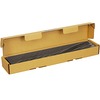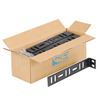Rack Cable Management
Use horizontal or vertical cable management panels to help organize your cables and give your network rack installation a professional look! Cable management panels are designed to mount directly onto any standard network wall mount rack, stand alone rack, or hinged rack to assist in dressing and routing cables between network devices and components. Cabling Plus offers a complete line of professional grade cable management panels that will fit any budget or project size. Choose the panels that best supports your network rack installation!
Use Cable Management to give your network rack a professional look!
Cable management is essential to any network cabling rack installation. Although cable management panels comes in many different forms and types their main purpose is to be attached directly onto any network rack for managing, organizing, and routing numerous network cables. On a common network rack there are often huge quantities of cables that need to be organized and dressed. Most of these cables consist of power cables, patch cables, cables that provide incoming services and signals, and cables that deliver signals out to various network devices. These network devices could consist of computers, telephones, fax machines, network routers, network switches, and network hubs. Most cable management panels come in different forms such vertical, horizontal, finger duct type, or ring type to support the design you are trying to accomplish. There are numerous different styles of cable management types so it is up to you to design the best solution that supports your application.
Another important factor of using cable management is that it simplifies future moves, addition, changes, and upgrades to a network. If all your network cables are cleanly organized in cable management panels it is much easier to move cables, add new cables, or even track cables in the event one goes bad. Making changes to a network is very common especially in commercial installations where employees are constantly moving locations or new equipment is often added for new employees. The bottom line is that if your cables are organized, and the proper cable management is in place, it is much easier to maintain and perform work on your network. Also, it is not uncommon for cables or connections to go bad on a network so using cable management helps you to easily trace and repair cables.
No professional network cabling application is complete without the use of quality cable management. At Cabling Plus we have numerous cable management options to support any size or type of network installation. Our cable management options are ideal for supporting both residential and commercial network installations. Choose the cable management you need to give your network rack a clean professional look!
Do I need to install cable management on my network rack?
You do not have to use any cable management when installing or dressing an equipment rack. But if you want to have a professional and clean look it is highly recommended. Adding cable management rings or panels is very simple, and it is the best way to cleanly dress and route cables throughout a rack. Using some type of cable management also makes it much easier to add, repair, remove, or change cabling in the future.
How do I install cable management on my equipment rack?
There are numerous panels available to assist in cable management. Panels are available that can be mounted on the side of a rack to assist in vertical cable management, and there are panels that can be mounted on the front of a rack to assist in managing cables horizontally. There are also other types of peripherals like individual rings and L brackets that can be used to support unique rack configurations. All cable management options are designed to mount directly to the equipment rack. Most quality equipment racks come with numerous hole configurations to support a wide variety of cable management options. They also come with the screws you need for a quick installation.
What is the purpose of using a “Rack Blank Panel” on my rack?
A blank rack panel is used to fill open gaps on a rack. If you have open rack mount spaces it is much cleaner looking to fill these open gaps with blank panels. They will give your rack a more professional look while allowing you to simply remove them in the future if you add to the rack and need to use the available space. Blank rack panels include mounting screws and support the standard 19” format of a rack. They come with the required mounting screws and can be installed in just a matter of minutes.
What is the purpose of using Horizontal Rack Cable Management?
The horizontal panels mount to the sides of a rack and can be used to channel cables to the top or bottom of a rack. They allow you to easily manage cables as they travel horizontally in and out of the rack as they attach to the required components and devices. Since most racks have numerous cables being used to transmit network signals between components and devices, using horizontal cable management panels is vital to the overall infrastructure of a rack. The last thing you want is to have a messy rack that makes working on equipment more difficult than it has to be. Plus, since most racks are out in the open, you for sure want to have a clean professional look.
What is the purpose of using Vertical Rack Cable Management?
There is a huge variety of vertical panels available to help manage cables within a rack. Most vertical panels offer rings or finger ducts that are used to support and manage cables. Most installers mount vertical panels in the front or back of patch panels or other high density cable areas to assist in routing or managing cables as they leave one area and travel out to other components and devices. Again, using vertical cable management panels is all about creating a professional rack look that is easy to work on in the future.
How do I choose the right panel for my new rack installation?
There are different cable management panels available to support the smallest or largest network rack installations. Some panels are 2 rack mount spaces and have larger cable rings to support larger then normal cable bundles, where some are smaller and designed to manage just a couple of cables. It is important to put some time into designing your rack configuration so you can determine the number of cables that need to managed, the types of cable management you need, the number of rack mount spaces needed to support all the technology that will be housed on the rack, and the location on the rack where all the components will be mounted. The more planning you do when building a rack the easier the installation will be, plus the final product will look much more organized.
How do I manage cables on a wall mount rack or server cabinet?
There is no difference in managing cables on a stand-alone rack, server cabinet, wall mount enclosure, or wall mount rack. The cable management panels will fit on or in them the same. You simply mount the panels to the rack or inside the enclosure and you are ready to start routing and dressing cables.
Which cables do I use cable management for?
A standard rack installation uses all types of cables to support the power, communications, and network connectivity. These cables can include power cables, telephone cables, patch cables, Cat5e cables, Cat 6 cables, fiber-optic cables, coaxial cables for video, and multi-conductor cables for powering access control, security, and surveillance devices. All cables can be easily managed using horizontal and vertical cable management panels.
Should I use Velcro or zip-ties to fasten cables on a rack?
Most professional installers will use a combination of panels and Velcro to organize and manage cables throughout a rack. Velcro straps are much more professional looking and will also simplify moves, adds, and changes. If you use zip-ties than you will have to cut them if you want to make any future changes, where using Velcro straps allows you to pull the straps apart and re-use them when make changes. Velcro is by far the much better product to use for dressing cables or bundling cables as they are pulled and installed.































